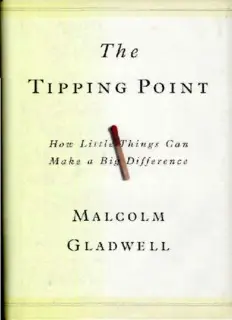Table Of ContentT HE
T I P P I NG P O I NT
How Little Things
Can Make a Big
Difference
MALCOLM GLADWELL
LITTLE, BROWN AND COMPANY
BOSTON • NEW YORK • LONDON
Copyright © 2000 by Malcolm Gladwell
All rights reserved. No part of this book may be reproduced in any form or
by any electronic or mechanical means, including information storage
and retrieval systems, without permission in writing from the publisher,
except by a reviewer who may quote brief passages in a review.
First Edition
The author is grateful for permission to include the following previously
copyrighted material:
Excerpts from interviews on Market Mavens videotape by Linda Price,
Lawrence F. Feick, and Audrey Guskey. Reprinted by permission of the authors.
Exerpts from Daniel Wegner, "Transactive Memory: A Contemporary Analysis
of the Group Mind." Journal of Personality and Social Psychology (1991),
vol. 61, no. 6. Reprinted by permission of the author.
Exerpts from Donald H. Rubinstein, "Love and Suffering: Adolescent Social
ization and Suicide in Micronesia," Contemporary Pacific (Spring 1995), vol. 7,
no. l, and "Epidemic Suicide Among Micronesian Adolescents." Social Science
and Medicine (1983). vol. 17. Reprinted by permission of the author.
Excerpts from Paul Revere's Ride by David Hackett Fischer. Copyright © 1994
by Oxford University Press. Reprinted by permission of the publisher.
Library of Congress Cataloging-in-Publication Data
Gladwell Malcolm.
The tipping point: how little things can make a big
difference / by Malcolm Gladwell.
p. cm.
Includes index.
ISBN0-316-31696-2
1. Social psychology, 2. Contagion (Social psychology) 3. Causation.
4. Context effects (Psychology) I. Title.
HM1033.G53 2000
302--dc21 99-047576
10 9 8 7 6 5 4 3 21
Design: Meryl Sussman Levavi/Digitext, Inc.
Printed in the United States of America
To my parents,
Joyce and Graham Gladwell
Downloaded from www.lifebooks4all.blogspot.com
Contents
Downloaded from www.lifebooks4all.blogspot.com
Introduction 3
ONE
The Three Rules of Epidemics 15
TWO
The Law of the Few:
Connectors, Mavens, and Salesmen 30
THREE
The Stickiness Factor:
Sesame Street, Blue's Clues,
and the Educational Virus 89
VIII THF TIPPING POINT
FOUR
The Power of Context
(Part One): Bernie Goetz and the Rise and
Fall of New York City Crime 133
FIVE
The Power of Context
(Part Two): The Magic Number
One Hundred and Fifty 169
SIX
Case Study: Rumors, Sneakers, and
the Power of Translation 193
SEVEN
Case Study: Suicide, Smoking,
and the Search for
the Unsticky Cigarette 216
EIGHT
Conclusion:
Focus, Test, and Believe 253
Endnotes 260
Acknowledgments 271
Index 273
T HE
T I P P I NG P O I NT
Introduction
or Hush Puppies — the classic American
F brushed-suede shoes with the lightweight crepe
sole —- the Tipping Point came somewhere
between late 1994 and early 1995. The brand
had been all but dead until that point. Sales were down to
30,000 pairs a year, mostly to backwoods outlets and
small-town family stores. Wolverine, the company that
makes Hush Puppies, was thinking of phasing out the
shoes that made them famous. But then something strange
happened. At a fashion shoot, two Hush Puppies execu
tives — Owen Baxter and Geoffrey Lewis — ran into a
stylist from New York who told them that the classic
Hush Puppies had suddenly become hip in the clubs and
bars of downtown Manhattan. "We were being told," Bax
ter recalls, "that there were resale shops in the Village,
in Soho, where the shoes were being sold. People were
going to the Ma and Pa stores, the little stores that still
carried them, and buying them up." Baxter and Lewis
4 THE TIPPING POINT
were baffled at first. It made no sense to them that shoes
that were so obviously out of fashion could make a come
back. "We were told that Isaac Mizrahi was wearing the
shoes himself," Lewis says. "I think it's fair to say thai at
the time we had no idea who Isaac Mizrahi was."
By the fall of 1995, things began to happen in a rush.
first the designer John Bartlctt called. He wanted to use
I lush Puppies in his spring collection. Then another Man
hattan designer, Anna Sui, called, wanting shoes for her
show as well. In Los Angeles, the designer Joel Fitzgerald
put a twenty-five-foot inflatable basset hound — the sym
bol of the Hush Puppies brand — on the roof of his Hol
lywood store and gutted an adjoining art gallery to turn it
into a Hush Puppies boutique. While he was still painting
and putting up shelves, the actor Pee-wee Herman walked
in and asked for a couple of pairs. "It was total word of
mouth," Fitzgerald remembers.
In 1995, the company sold 450,000 pairs of the classic
Hush Puppies, and the next year it sold lour times that,
and the year after that still more, until Hush Puppies were
once again a staple of the wardrobe of the young Ameri
can male. In 1996, Hush Puppies won the prize for best
accessory at the Council of Fashion Designers awards din-
ner at Lincoln Center, and the president of the firm stood
up On the stage with Calvin Klein and Donna Karan and
accepted an award for an achievement that — as he would
be the first to admit — his company had almost nothing to
do with. Hush Puppies had suddenly exploded, and it all
started with a handful of kids in the East Village and Soho.
How did that happen? Those first few kids, whoever
they were, weren't deliberately trying to promote Hush

